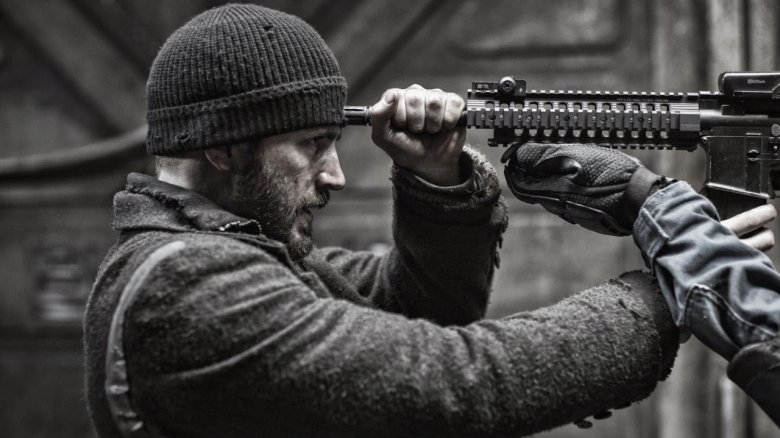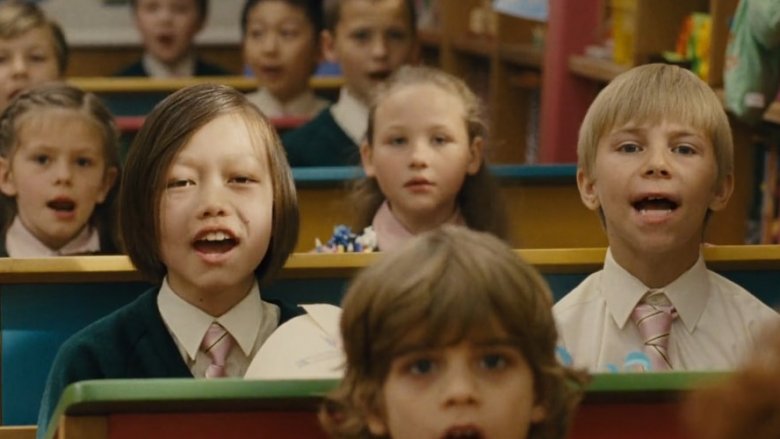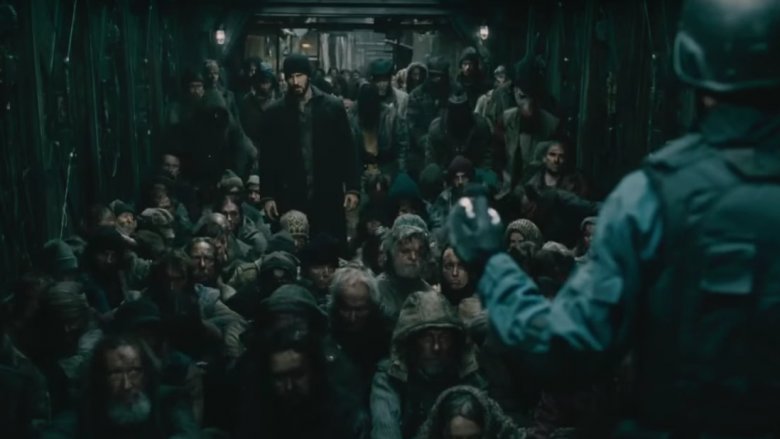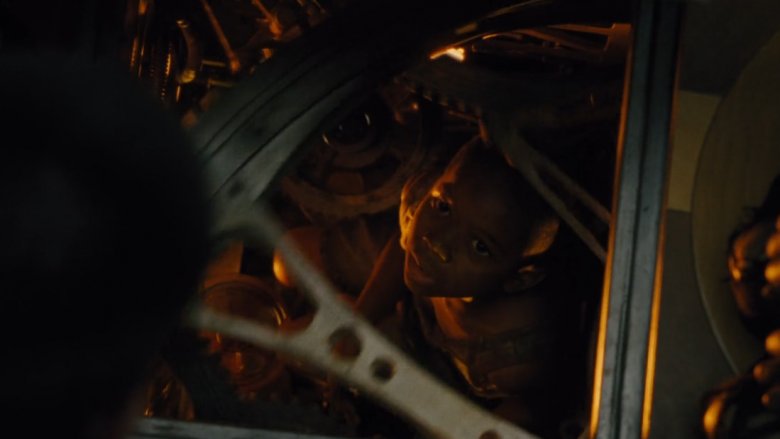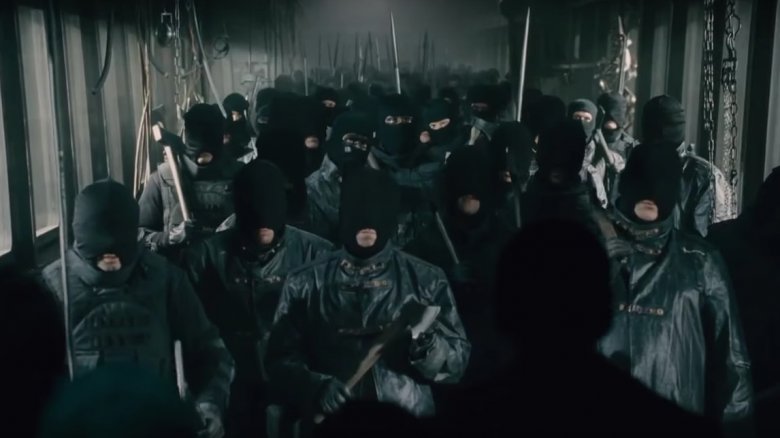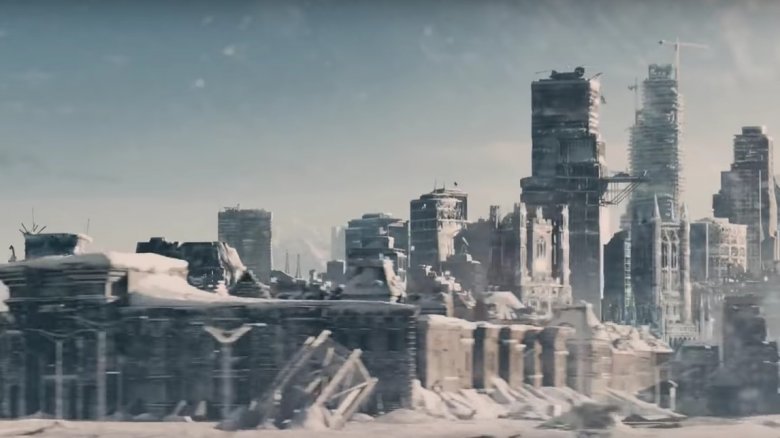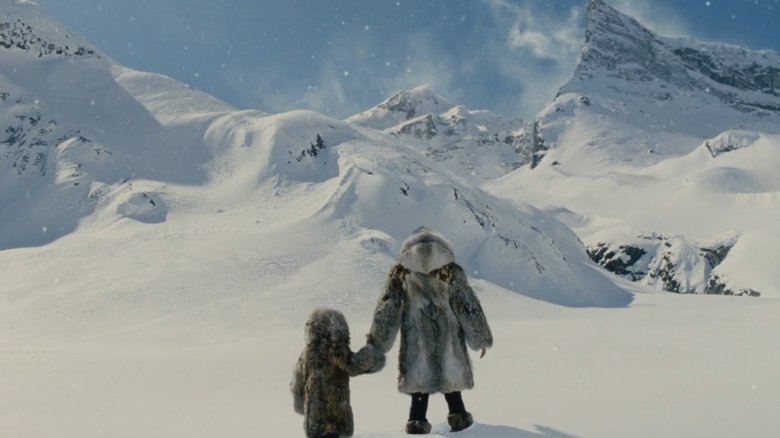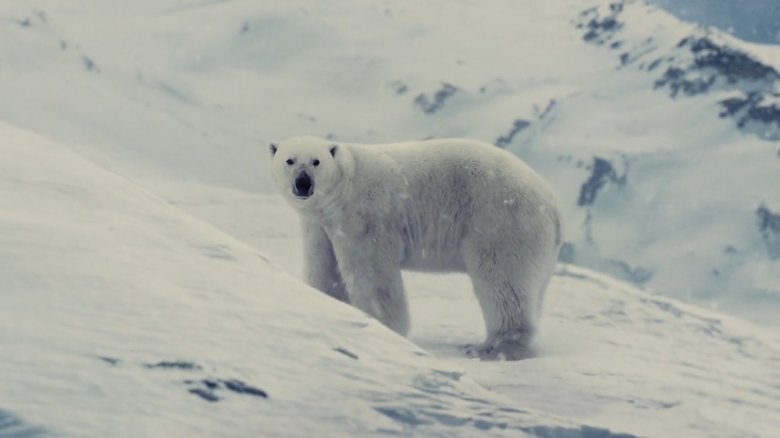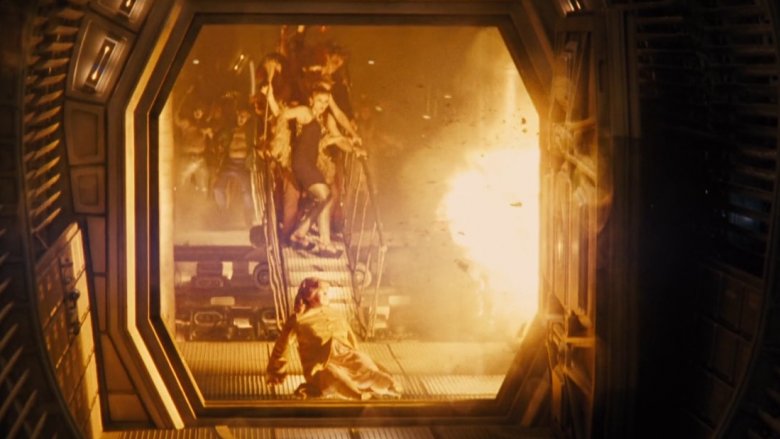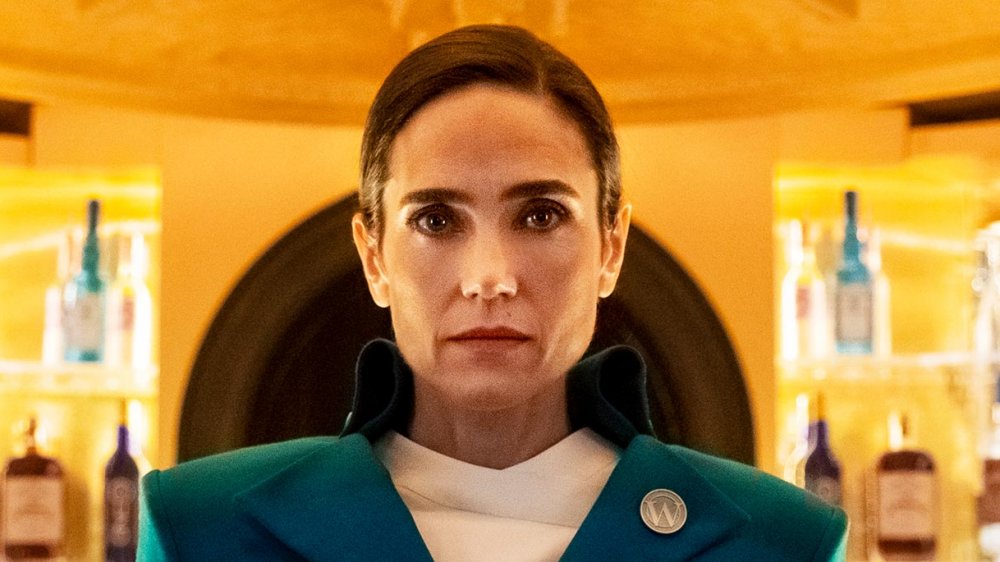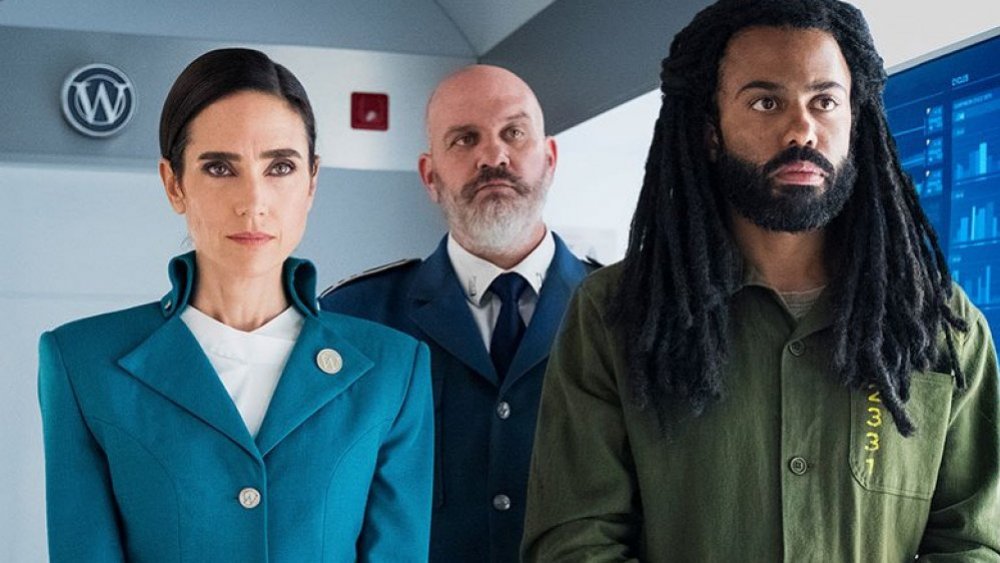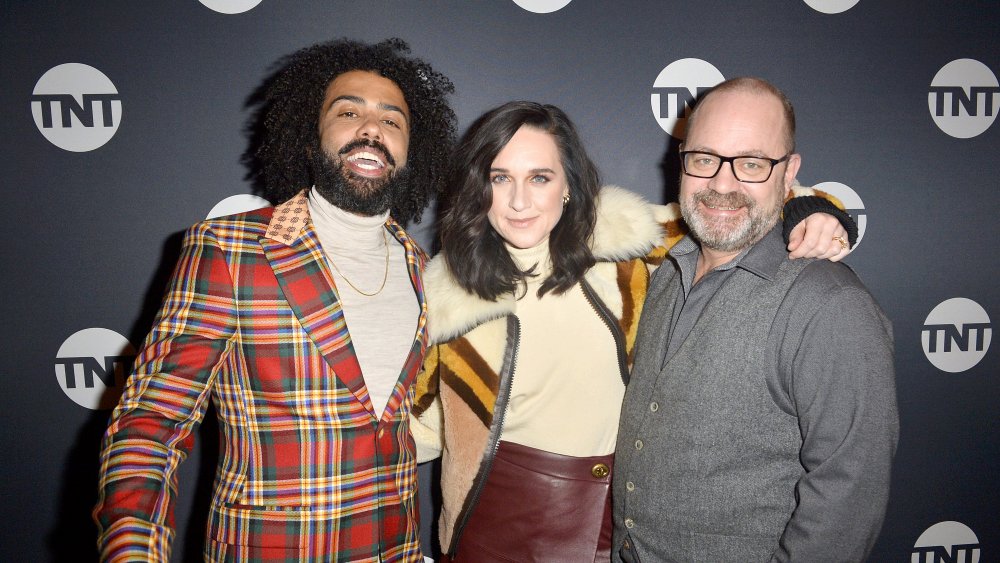The Ending Of Snowpiercer Explained
Since the 2013 release of the South Korean/Czech sci-fi action movie Snowpiercer, audiences everywhere have declared director Bong Joon-ho's film as one of the best action movies of the decade. They've also, however, been left scratching their heads at the film's ending. With the filmmaker gaining more international attention than ever after Parasite's Oscar win for Best Picture — not to mention a Snowpiercer TV series hitting the screen in the summer of 2020 — there's no better time to revisit this dystopian thrill ride.
If you count yourself among the many who aren't quite sure what to make of the movie's dramatic conclusion, fear not! We're here to explain exactly what's going on with that polar bear — and everything else. (But before we board the train, be warned: Spoilers ahead.)
All aboard
First and foremost, let's get one thing straight: The social structure inside Snowpiercer's titular train is meant to mirror our own present-day global society — the haves, the have-nots, and everyone occupying a "preordained position" in the socioeconomic structure.
Just as today's rich live in penthouses and the poor live in shanties, Snowpiercer's wealthy elite "belong the front," while its poor inhabitants "belong the tail." More importantly, however, is the fact that all those aboard the Snowpiercer are trapped on the same train, regardless of which car they occupy, just as humanity is confined to sharing a single planet with divided societies.
"I wanted to emphasize the idea of the train, the physical train, as an iron box or metallic prison," Joon-ho explained to Vulture. "There are so many characters, but they're all stuck inside. They say they want to move to the front, and they fight to get there, but they're still ultimately inside the train."
We, too, are ultimately stuck inside our own train, but it's not called Snowpiercer. Rather, it's called Earth. And no matter how hard we might try to get ahead, we can never truly escape.
Occupy Snowpiercer
Remember the Occupy Wall Street protests which began in 2011? Political views aside, the movement successfully put the notion of gross wealth inequality into the mainstream consciousness by specifically pointing out the drastic difference between the world's wealthiest 1% and the other significantly less wealthy 99%. Since Snowpiercer's titular train is a fictional representation of our own society, it's easy to see how the film portrays a viewpoint not entirely dissimilar to those who protest economic inequality.
As one progresses toward the front of the train, conditions improve and become more and more similar to that of wealthier areas in Europe and North America. Unfortunately, the majority of the Snowpiercer's population occupies the tail of the train, where conditions are hardly better than those in the poorest places on Earth. All the way in the back, the train's poor population is kept well out of sight and out of mind, with some working-class train cars acting as a buffer in between. Our world is similar, the focus on the needs of our own working class offering a buffer from horribly impoverished nations like, say, Burundi.
The Great Engine's Power
Throughout Snowpiercer, we are constantly reminded that the great engine powering the train is "eternal," leading us to believe it's powered by some sort of perpetual motion mechanic — but it's not.
The Snowpiercer's engine, much like industry in some parts of the world, is powered by child labor. Children were an unfortunately large part of the workforce in much of the United States, Europe, and associated colonies throughout the 19th and early 20th centuries before legislation put a stop to the exploitative practice in most of the developed world. The practice still exists, however, with the International Labour Organization claiming 152 million children worldwide are subject to child labor. Just as the child slaves aboard the Snowpiercer are hidden beneath the floorboards in the engine room, the global economy's partial reliance on exploitative and cheap labor — whether in sweatshops or in agriculture — is commonly kept below the surface, for all to ignore.
Marxism, Snowpiercer style
Those aboard the Snowpiercer are kept in check in ways similar to our own current society.
According to the 20th century French Marxist philosopher Louis Althusser, those in power maintain societal order through two institutions. The first is called the Ideological State Apparatus, which aims to subconsciously teach us all to remain our own preordained train cars, if you will. No place is this better exemplified than in the Snowpiercer's classroom, where children are brainwashed into accepting the train's inequality.
The second institution, called the Repressive State Apparatus, physically keeps societies in check when ideology isn't enough. These commonly come in the form of police officers and military forces. The Snowpiercer's police force is seen early on. However, when they fail to keep the order later on, the train's military — ax-wielding brutes in black masks and night-vision goggles — steps in. Sound familiar?
As a last resort, the train's leadership calls upon a small force of elite operatives with superior weaponry; these operatives serve as the last line of defense against a violent insurrection. There's even a CIA-like line of communication between the front of the train and the back. Big Brother's always listening.
Save the Planet?
Enough about class politics; there's much more going on in Snowpiercer than just socioeconomic commentary. The film also reminds us that we're putting ourselves on the path to natural extinction.
Humanity has long seen itself as either the conquerors or shepherds of nature, one minute attempting to destroy the Earth and tasking itself with saving it another. Nothing could be more conceited. Planet Earth will exist long after humanity has come and gone, and there's no machine we can build to keep us around. Snowpiercer remind us of that.
"Inside the train, kids are taught that if you go outside, you're going to die," Joon-ho explained. "But outside the train, life is actually returning. It's nature that's eternal, and not the train or the engine, as you see with the polar bear at the end."
Furthermore, it's actually Mother Nature which really puts humanity in its icy grave, not the homemade explosive of the film's climax. "It's the avalanche that kills everyone else," Joon-ho reminds us. "It's the revenge of nature, if you will."
And yes — in case you were wondering — the avalanche did, in fact, kill everyone left on board the Snowpiercer. "Yes, they're all dead," Joon-ho claims, "and that's a bit harsh. But it's a sci-fi film: If you can't say these things, or have these ideas in a sci-fi film, where can you?"
The human race will survive...
Before you get too depressed by Snowpiercer's message, know that all is not lost.
According to the film's director, humanity manages to beat the odds by not only surviving but repopulating the Earth. "For them to procreate, it's going to take a little time" he explained. "So, for me, it's a very hopeful ending. But of course there are so many deaths, and so many sacrifices ... it's not so sweet. But those two kids will spread the human race."
Apparently, the Earth can't get rid of us that easily.
...Or not.
Sure, we're shown that life outside of the train can exist. And sure, the director has told us that the two survivors will successfully manage to repopulate the Earth like a post-apocalyptic Adam and Eve — but will they really?
First of all, the two kids have never once stepped foot outside the Snowpiercer, having been born aboard the titular train. As Joon-ho reminds us, "There's an expression in the film: 'train baby.' Those are the two kids that survive, the ones that only knew life on the train ... These kids have never known what it was like to step on the earth. So it's almost like Neil Armstrong touching down on the Moon when they leave the train for the first time." As optimistic as we'd like to be, what are the odds of two aliens surviving in the harsh wilderness, without any basic survival skills?
Worse yet, humanity's last hope comes face to face with a freakin' polar bear! Let's be real — that's not exactly a good start to life outside the train. Polar bears are one of the most dangerous animals on the entire planet, and historically have no qualms about soaking their beautiful white fur in human blood. Worse yet, if there's one polar bear right outside the train, it stands to reason that there are more on the snow-covered horizon. Sorry Joon-ho, we're not liking those chances.
A radical message
Snowpiercer is more than just a sci-fi action movie. It's a commentary on our global socioeconomic structure as well as a statement regarding our futility against the powers of nature. More than anything, however, the film has an even more radical underlying message: The only way to fix social inequality is to destroy the very foundations of our society.
Not only do most of the train's inhabitants die from fighting before the avalanche occurs, the train itself is already on its way out. The engine is failing, the system is corrupt, and extinction is imminent. No matter how hard our heroes fight to get to the front, they are hopeless to fix the train's inherent problems. The Snowpiercer was never really going to last forever — and neither are we.
Snowpiercer suggests that only a hard reset can solve society's woes. Our civilization needs to be buried beneath the snow before new structures can be built. The matchbook of humanity needs to be stripped down to its very last matchstick, only then can we burn brightly.
The ending of the movie isn't the end of Snowpiercer
After the film's release in 2013, Snowpiercer remained a fan favorite, so it's no surprise that entertainment higher-ups decided to create a spin-off for the small screen. In 2015, the film rights were purchased by Tomorrow Studios, and Bong Joon-ho signed on as an executive producer alongside showrunner and writer Josh Friedman. The show was officially picked up in 2018.
Set seven years after the original story, this new version of Snowpiercer starts off in the same way — specifically, in a train divided by social and economic classes — but features entirely new characters and new dynamics, not to mention a brand new story. Just as in the original film, the train never stops moving, giving audiences plenty of time to explore the complicated relationships and fraught tensions between the wealthy people at the front of the train and the people at the back, who occupy the lowest rungs of society.
Who's set to appear in the Snowpiercer TV series?
It might seem impossible to top the original cast of Snowpiercer. After all, the movie starred Captain America himself, Chris Evans, backed by Academy Award-winner Octavia Spencer and prestigious character actress Tilda Swinton, but famous faces lined up quickly to appear in the television adaptation as well. Another Oscar winner, Jennifer Connelly, and Daveed Diggs, who won a Tony award for his supporting role in the original cast of Hamilton, will head up the series. Connelly plays Melanie Cavill, the wealthy Voice of the Train who is fascinated with the lower class. Diggs takes the role of Layton Well, a lower class passenger who is content tending to his rats and trying to survive, but finds himself swept up in a revolution.
Other recognizable faces like Alison Wright (The Americans) and Rowan Blanchard (Girl Meets World) are set to appear on the show, and one big name has signed on without revealing his role — Sean Bean, known for fantasy fare like Game of Thrones and Lord of the Rings, has signed on for the show's second season as a regular.
Snowpiercer's next journey has faced multiple delays
Snowpiercer's train might never stop, but this adaptation's engine has had some trouble leaving the station. Less than a month after Josh Friedman was announced as the series showrunner, he parted ways with TNT, citing "creative differences." Graeme Manson, who worked on Orphan Black before heading over to Snowpiercer, joined as the new showrunner, but drama struck once again when the network wanted the pilot reshot. Doctor Strange director Scott Derrickson, who helmed the original version of the pilot, refused to return for reshoots. As he tweeted in June of 2018, "The 72-page Snowpiercer TV pilot script by @Josh_Friedman is the best I've ever read. The feature-length pilot I made from that script may be my best work. The new show runner has a radically different vision for the show. I am forgoing my option to direct the extreme reshoots." Manson later commented on the delays, saying the show's constantly changing release date was, in fact, due to reshoots as the pilot was completely redone.
The show then moved from TNT to its sister network, TBS, but was also picked up for a second season; as of this writing, the show is set to premiere on May 17, 2020 on TNT.
